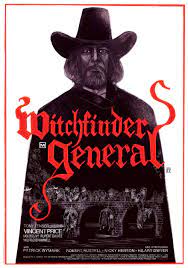
In 1645, during the English Civil War, Matthew Hopkins (Vincent Price), uses the breakdown in social order to appoint himself Witchfinder General and create a reign of terror in East Anglia. With his assistant John Stearne (Robert Russell), he would visit villages and torture suspected witches until they confessed, find them guilty, and kill them in various horrible ways. The villages would pay him for this.
A young roundhead soldier named Richard Marshall (Ian Ogilvy), after saving the life of his captain in battle, rides home to Brandeston, Suffolk, to visit his love Sara Lowes (Hilary Dwyer). Her uncle, the village priest John Lowes (Rupert Davies) gives him permission to marry Sara. There is trouble coming to the village and Marshall wants Sara out of there. After his leave is over and he is riding back to his regiment, Marshall meets Hopkins and Stearne on the road and gives them directions to the village.
In Brandeston , Hopkins and Stearne begin rounding up suspects. Father Lowes is accused and tortured with needles. To stop this before the priest is killed, Sara offers her sexual favors to Hopkins. When Hopkins is called away to another village, Stearne rapes her. Hopkins returns and discovers what Stearne has done, but he does not punish Stearnes. Instead, he refuses to have anything to do with Sara. Lowes is tortured again, and before leaving town, Hopkins and Stearne execute him and two women found guilty of witchcraft.
When Marshall returns, he is horrified and vows to kill Hopkins and Stearne. Marshall performs a marriage ceremony with Sara, tells her to leave for Lavenham, and rides off. Hopkins and Stearne have been separated by a roundhead patrol who commandeer their horses. Hopkins flees, and Stearne is able to escape and reunite with Hopkins, whom he tells about Marshall.
Hopkins and Stearne enter the village of Lavenham. Marshall rides off in their direction with some other soldiers, but Hopkins has set a trap. He accuses Sara and Marshall of witchcraft, seizes them, and interrogates them in the castle. Marshall witnesses Sara being tortured but refuses to confess. He breaks free and stomps on Stearne’s face, then attacks Hopkins with an axe. His soldiers are horrified and put Hopkins out of his misery. Both Marshall and Sara have now gone insane.
The film was directed by Michael Reeves from a screenplay by him and Tom Baker, quite loosely based on a novel by Ronald Bassett. It was made for 100,00 pounds. In the US, it was called The Conquering Worm, after a story by Edgar Allan Poe, to give the impression it was based on Poe’s work. The American version featured Vincent Price reading the poem. It has become a cult film and, though it was called sadistic in the beginning and had to be toned down before release, it eventually gained popularity among critics.
Matthew Hopkins and John Stearne were real people who travelled England as witchhunters from 1645 to 1647. Some 500 people, mostly women, were executed for witchcraft in England between the 15th and 18th Centuries, but Hopkins killed 300 of them in a couple of years. Before dying, he published The Discovery of Witches, calling himself the Witchfinder General. The novel by Bassett was published in 1966. When AIP insisted that the movie star Vincent Price instead of Donald Pleasance, as the director wanted, the nature of the character changed. Reeves wanted Pleasance to show what has been called the banality of evil—bureaucrat mass-murderers like we have now—and Hopkins was to be ineffectual, inadequate, and ridiculous, but Price could only portray him as a more traditional evil villain.
Price played the role quite straight and never resorted to camp or overacting, as he had been accused of doing. Price himself thought it one of his best performances. Director Reeves made no secret of the fact that he did not want Price and there was tension between them. In one argument, Price told him, “I’ve made 87 films. What have you done?” and Reeves replied, “I made three good ones.” When Reeves instructed Price to shoot off his flintlock pistol between the ears of his horse, Price refused at first, but did so eventually and the horse threw him. Price showed up drunk on the final day of shooting. Reeves told Ian Ogilvy to strike Price during a fight scene, which he did, but the producer Philip Waddilove had his costume padded. In the end, Price admired the film and they reconciled.
The pastoral beauty of the British landscape contrasted sharply with the horror and violence. Many critics decried the violence but others praised its power, and it was after all a horror picture. Reeves responded to the criticism by stating that violence should not be enjoyable. The film was supposed to be a tax write-off for AIP, but it turned out to be too good. In America, there was not the same reaction to the violence. The audience cheered when Hopkins was beaten to death, although the real Hopkins died in bed, and it made ten million US dollars. I tend not to react viscerally to movies—I’m too buy analyzing them to take them personally—but a scene in this film of a screaming woman being burned alive made me break out in a horrified cold sweat. Reeves got what he wanted out of me, at least.
